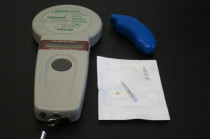MICROCHIPS
These can be simply inserted in a routine consultation by either a vet or a nurse. These are often inserted at vaccination or neutering. Registration is then done either Online or by post. We can register them online during the consultation if you have all your contact details to hand which is much quicker than relying on th post.
It is very important that if you change address /phone number or if the pet changes ownership that the registration details are updated. If not the chip becomes of limited use as you cannot be contacted when your pet is found.
If your pet goes missing reporting it missing to the database will increase your chances of it being returned.
We use the ANIMALCARE CHIPS - these are the original identichips. If you need to change your details or register a change in ownership then go to their website http://www.identichip.co.uk/pet-owner/microchipping/faq There is a one off fee to change details but that does allow for an unlimited number of changes. Different microchip registries will have different websites & further instructions on changing details will be found on their websites - there should be information on your original microchipping paperwork. Not all microchip databases are equal, some are harder for us to access trace the owner from so we would very much recommend that chips are registered wither with Identibase or Petlog.
If you have bred a litter of puppies that need microchippping (and legally they have to be originally registered to the breeder) then register as a breeder on the above website. This will allow you to register the puppies and do the first change to their new owners for free.
Microchipping is compulsory for dogs in the UK. Dogs have to be microchipped by 8 weeks of age and it will be an offence if contact details are not up to date.
Often we are presented with a straying animal which has an microchip but the details are out of date and we are unable to contact the owner. If we have a stray or injured animal brought to the practice, the presence of an microchip with up to date details means that we can reunite that pet with its owner as soon as we can make contact with them.
Identichips are not yet compulsory in cats but are a very good idea as outdoor cats do sometimes get lost & they often loose their collars. They can be used in conjunction with specialised cat flaps to ensure that only your cat can access your house. Non resident cats will sometimes come in through cat flaps, eat your cats food and unsettle the resident cat leading to stress related problems - typically spraying. There are even microchip activated cat feeders which can be handy if you have cats on different (ie prescription) diets.
Parrots and birds of prey can also be microchipped but to be done safely they have to be anaethatised to ensure that they are still.
This shows the microchip scanner, an microchip inside the needle used for inserting (in the sterile pack), and the blue gadget we use to fit the chip. The chip itself is marginally bigger than a grain of rice. Occasionally you can feel the chip through the skin on the back of your pets neck. They rarely malfunction but it is worth getting them checked at booster vaccination time.
Identibase and Petlog are the longest established databases and these are easy for us to access when we are presented with a 'found' pet. There has been a recent plethora of new microchip databases and these can be harder for us to access.







